Even if you’re a newbie when it comes to SEO, you’ve most likely heard about the importance of building a good backlink profile for your website.
It’s true that backlinks are a major search engine ranking factor and are critical to your success in getting visibility on Google and other search engines.
When you have relevant and high-quality websites linking back to your own website, this indicates that you can be considered an authoritative and trustworthy source.
That’s why backlinks should be given the right amount of attention in terms of:
- Trying to build the right backlinks
- Keeping only the backlinks that are beneficial to you
- Checking and measuring various link data to evaluate your backlink profile
Plus more, which we’ll go through, step-by-step, in this detailed guide.
Without further ado, let’s get started.
Disclaimer: Throughout our guide, we’ll be using the popular SEO software Ahrefs. It’s one of many available and you can choose which will work best for your needs. Free tools like Google Analytics generally don’t feature SEO backlink audit functionality.
Link building cheat sheet
Step #1: Conduct a Competitive Analysis
Conducting a backlink audit is one of the most important elements when it comes to auditing the overall health of a website.
A phrase we like to use to describe this process is “link detox”.
Obviously, the process of backlink analysis is multidimensional and many factors should be taken into consideration in order to have a healthy backlink profile and, therefore, a better-performing website and digital marketing strategy.
The first step is to conduct a competitive analysis; this means gathering a few websites that are relevant to yours – preferably your direct competitors – and comparing your backlink profiles.
That way, you’ll be able to spot potential weaknesses you may have in order to not get left behind.
Let’s have a look at the first step, which is the domain comparison.
Domain Comparison
To begin with, we’ll use the domain comparison feature of the Ahref backlink audit software.
Of course, you can feel free to use any search engine optimization and backlink analysis tool you like such as Moz Link Explorer, Majestic, Semrush, or any other software that provides a backlink checker.
In our case, what you want to do when in Ahref’s dashboard is to click on “More”.

You’ll then be presented with a drop-down list with many options to choose from, such as Alerts, Batch Analysis, and Link Intersect.
Let’s click on “Domain Comparison”.
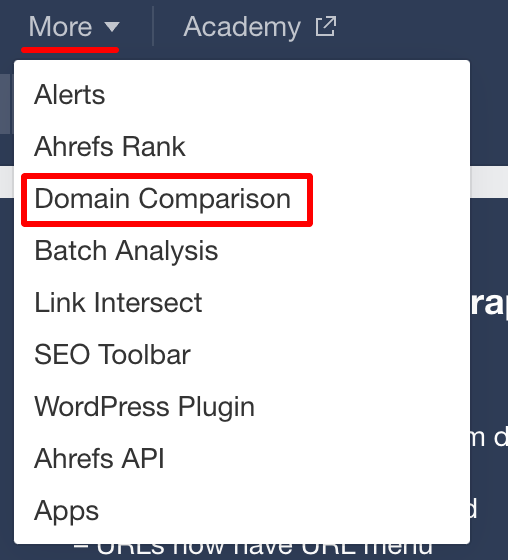
You can then enter up to five domains to compare with each other.
We’ve chosen to compare our own website, Respona, with four competitors.
Simply enter the domains you want and click on “Compare”.

The tool then presents you with detailed information about each domain, such as its domain rating, the referring domains, the number of backlinks, and other link data.
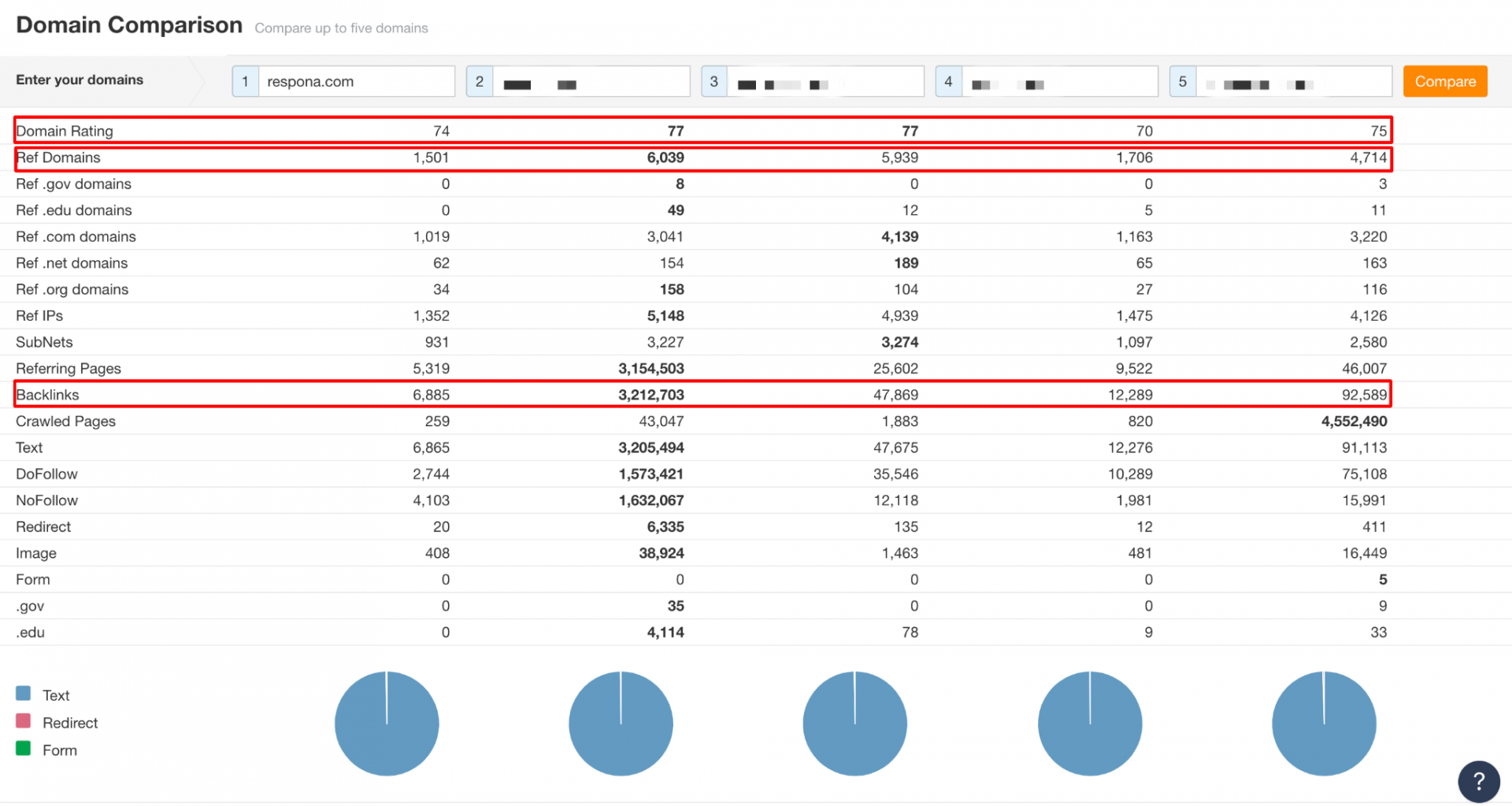
As you can see, when a domain is stronger in a certain aspect compared to its competitors, the number is marked in bold.
Let’s break down a few of the most important metrics which you should pay attention to:
- Domain Rating (DR): It shows the strength of a website’s backlink profile on a scale of 1-100.
The higher the DR, the more valuable the links you get from it are, as long as the website is relevant to yours.
- Referring domains: This shows the total number of unique domains linking back to a certain website.
- Referring pages: This shows the total number of unique pages linking back to a certain website.
- Backlinks: The number of links from other websites linking back to a certain website.
Of course, as you can see in the screenshot above, there are many more metrics you can measure, but these few give you a good indication of where you stand compared to other, similar websites.
For instance, by looking at competitor’s backlinks you can see whether you’re lacking in that area.
If you are behind the curve, you should probably create a good link building strategy, which will consequently increase your domain authority as well as page authority.
Keep in mind that the number of backlinks itself doesn’t necessarily mean a lot; what matters most is the link quality.
Are they high quality backlinks or low-quality ones? Are they from relevant sources or irrelevant ones?
These are only a few of the things you should look out for in the link audit process, which we’ll cover further on in this guide.
What else can we get from the domain comparison page?
TLDs (Top-Level Domains)
Ahrefs also does a great job in providing us with the TLDs (top-level domain) each website has, meaning whether their ending is “.com”, “.org”, “.gov” and so on.

It’s good to keep in mind that search engines, in general, prefer diversity when it comes to domain types, as long as an unusual TLD doesn’t take up a large proportion of the total amount; we’ll elaborate more on this in step number four.
However, if you’re a local business from the UK for instance, it’d be better for the majority of the links to be in the “.co.uk” format, while if you’re from the US you’d want more “.com” links.
Another interesting metric to look at is the NoFollow to DoFollow link ratio.

You can also get a better view of this ratio from the pie charts available.

We’ll elaborate more on these types of SEO links in the fifth step.
Referring Domains and Pages
Further down, Ahrefs provided us with another chart where we can clearly see the progress each domain has made over the years when it comes to referring domains, new-lost referring pages, and referring pages.
Let’s have a look at the referring domains chart.
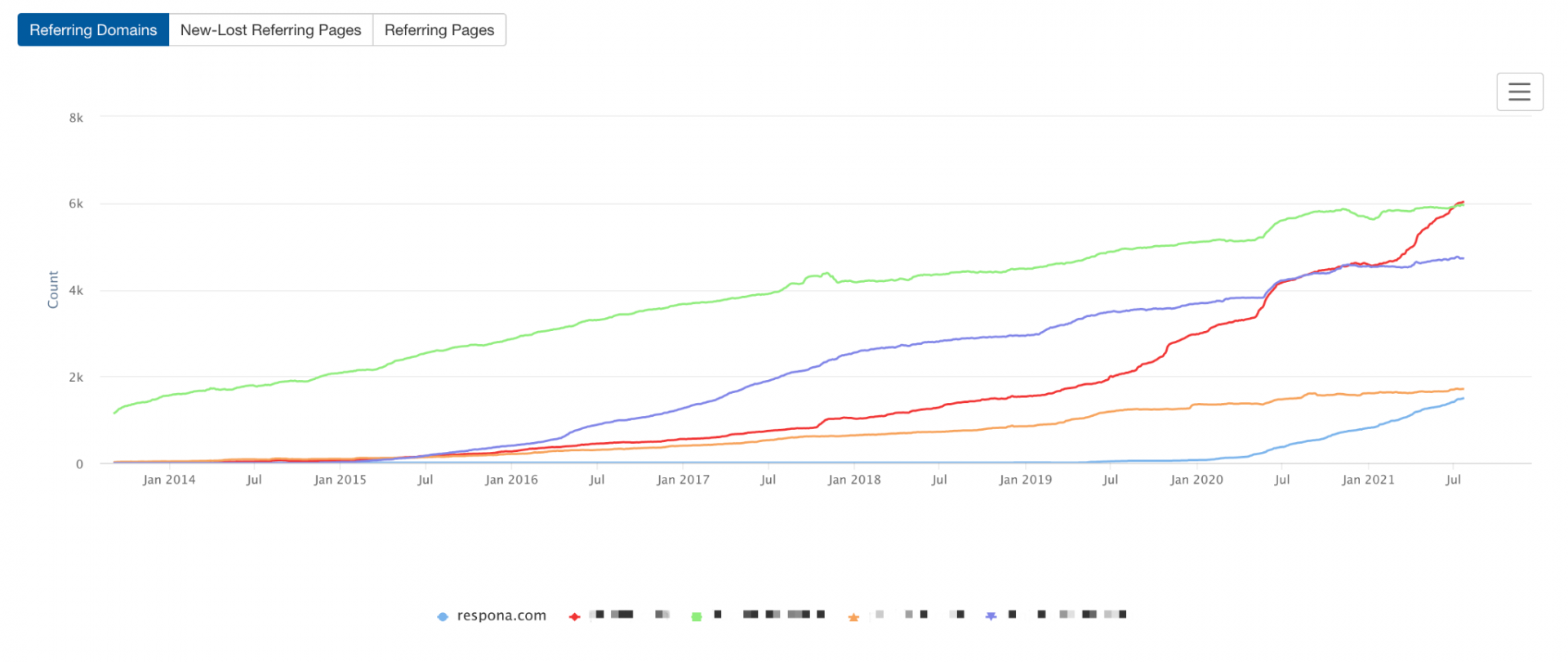
As you can see, each domain is associated with a different color so each one’s progress is more visible compared to the others.
Let’s go to the top left and switch to the New-Lost Referring Domains.
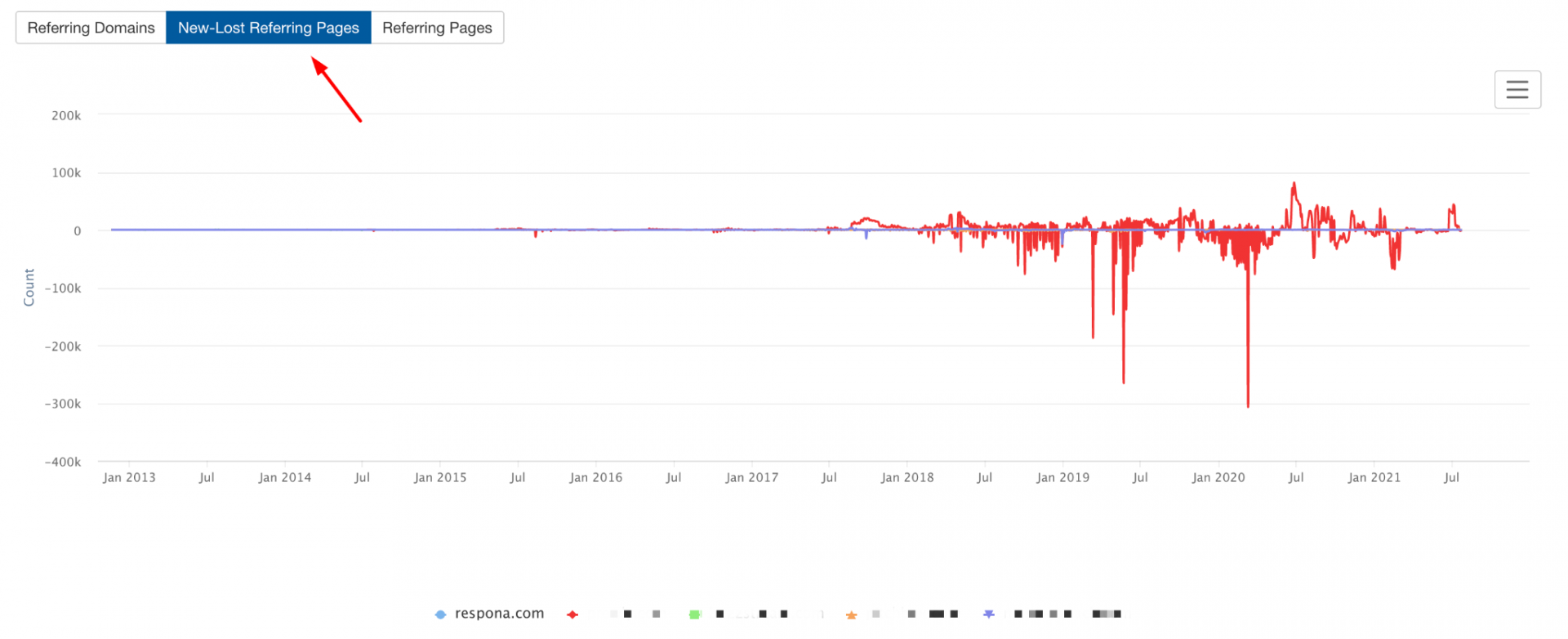
What we notice is that one particular competitor – the one in red – has significantly more volatility, especially considering the lost referring pages, while the rest are more stagnant.
Lastly, we can switch to the Referring pages and see the progress all domains have made over the years in that area.
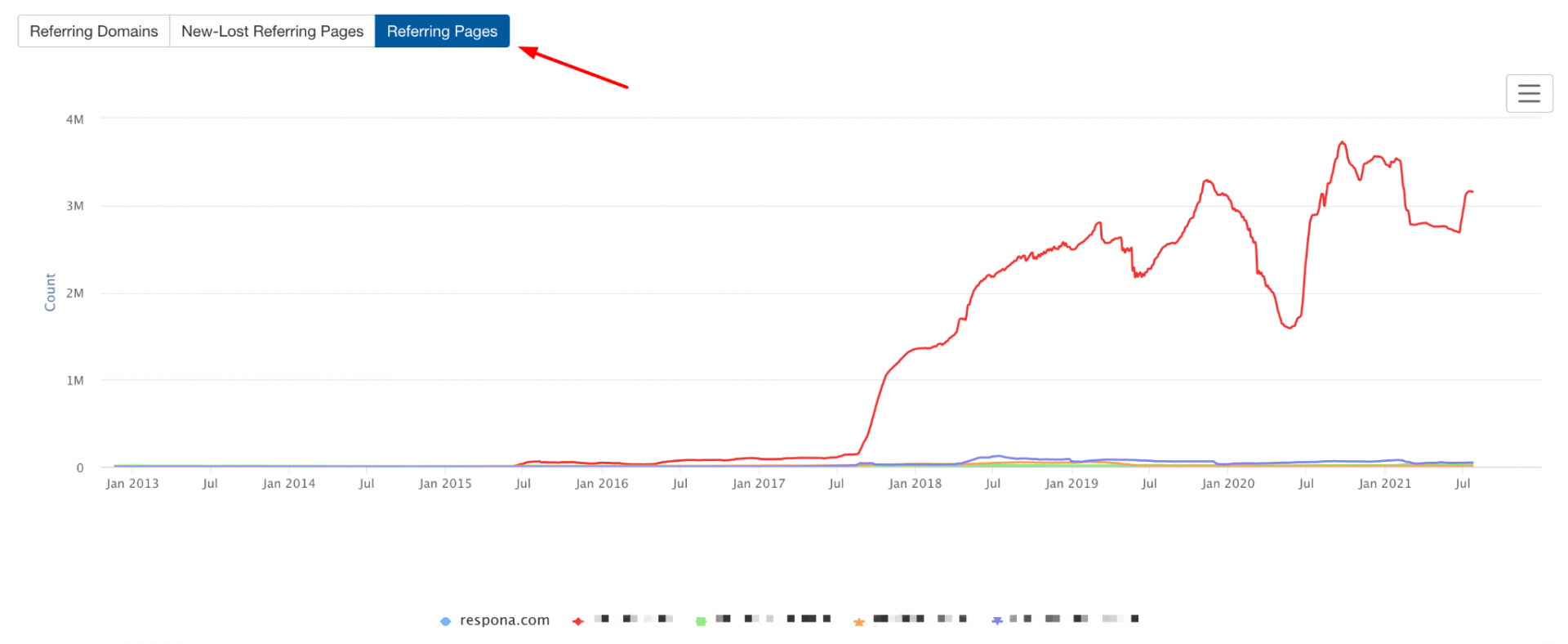
All-in-all, these are the key details you can see in Ahrefs’ Domain Comparison tool.
It gives you a great overview of where you stand in the market in terms of your link profile so you can make decisions based on an all-around approach.
Now, let’s see another tool you can take advantage of when conducting a competitive analysis.
Link Intersect
The Link Intersect tool basically shows you a list of backlinks that link back to your competitors but not you.
All you have to do to access it is go to the overview of Site Explorer and click on “Link Intersect” from the menu on your left.
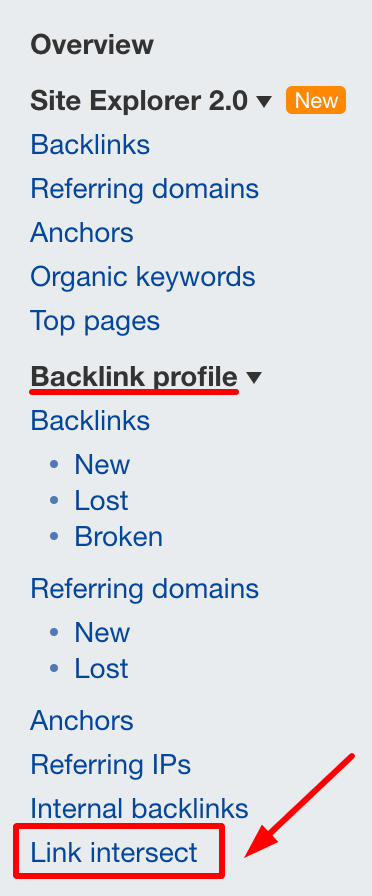
You’ll then need to add up to ten relative domains that you wish to compare to your own.
In our case, we’ve used the same four competitors as in the previous step in order to see the number of domains.
When you’re done adding them, you can click on “Show link opportunities”.
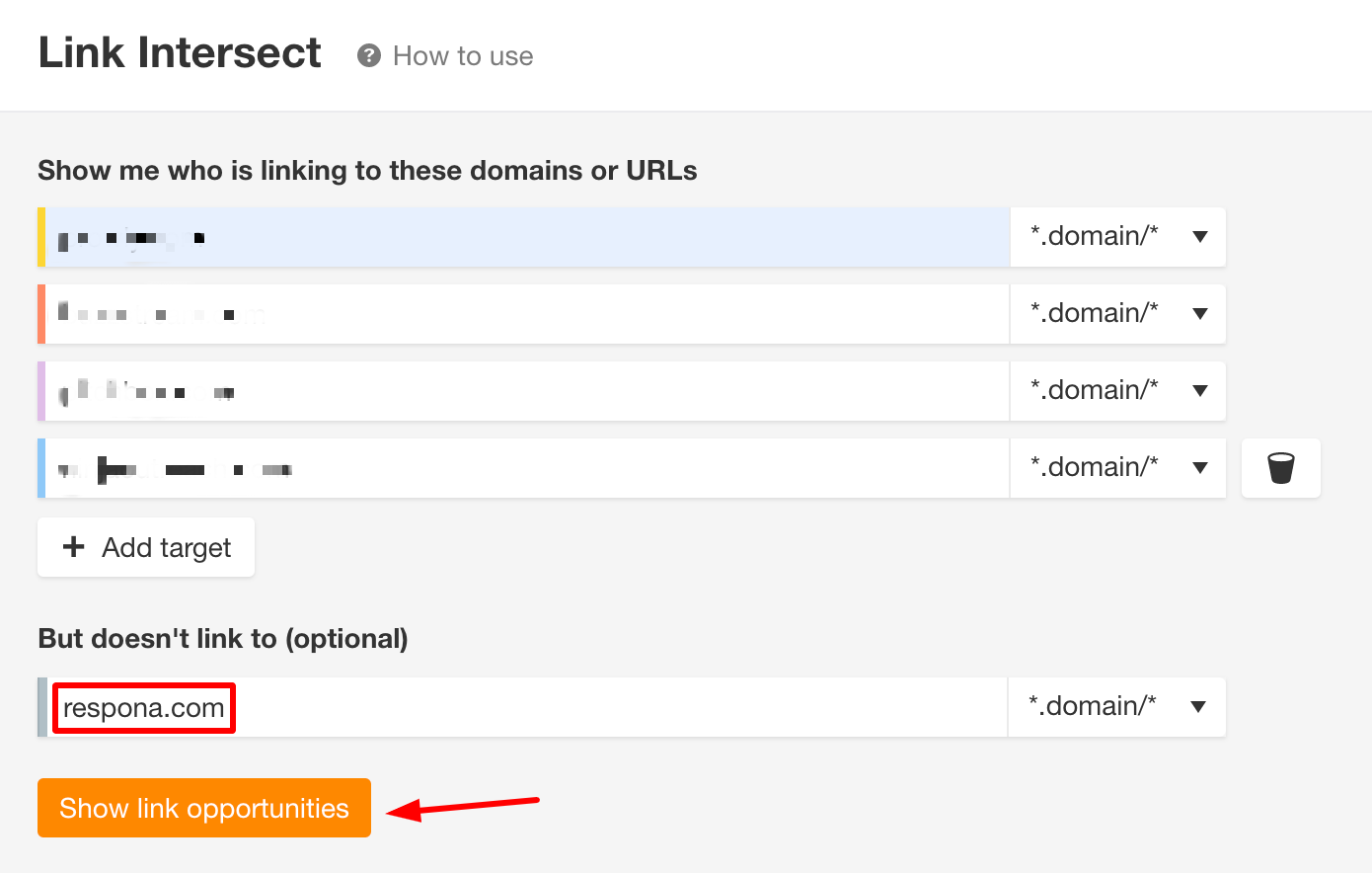
As you can see in the screenshot, there are almost 14.000 domains that link back to our competitors but not our own site.
Next to each domain, you can see stats such as the DR, the Ahrefs Rank, and the Intersect.
The last one shows you how many of your competitors share the same domain as a backlink.

For instance, since the first domain has an Intersect of four, this means that it links back to all four of our selected websites.
This tool gives you a great inside look into the backlink gap between you and your competitors, helping you bridge it by reaching out to the right websites for link building.
Let’s move on to the second step.
Step #2: Check Your Link Velocity
The second step to a successful backlink audit is to check your link velocity.
This is the pace by which you acquire new links and is quite easy to spot in an SEO tool like Ahrefs.
By simply going to the overview page of your website, you can see a few key stats, such as your URL Rating (UR), DR, backlinks, referring pages, organic keywords, and more.

What we’re most interested in at this stage are the referring domains and referring pages, which you can see in detail if you scroll further down.
Referring domains
As we noted earlier, the referring domains show the number of unique domains linking back to your website.
For example, if website X has linked back to you several times in its content pieces, it’ll count as one because they all come from the same source.
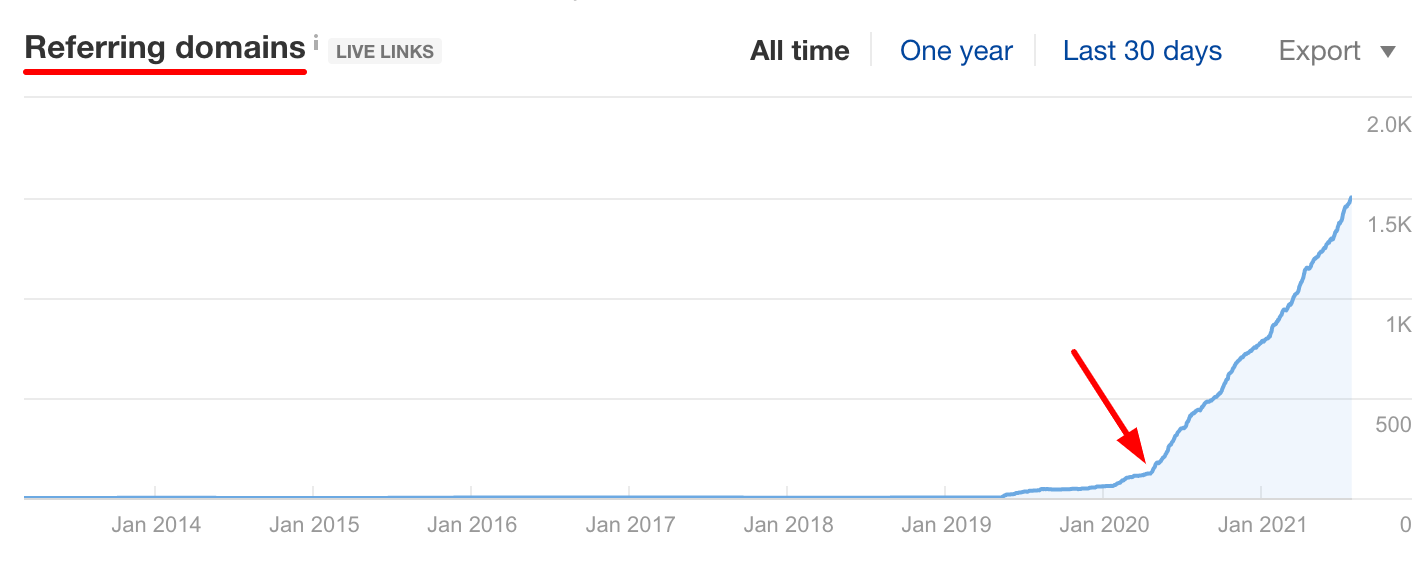
In our case, the referring domains are growing relatively fast but the pace really picked up after around April of 2020, helping us boost our DR and organic search traffic.
Let’s have a look at the referring pages.
Referring pages
This metric shows us the unique number of web pages linking back to our website.
Naturally, it has a positive correlation with the Referring domains, so it’s no coincidence that it also really took off after April 2020.
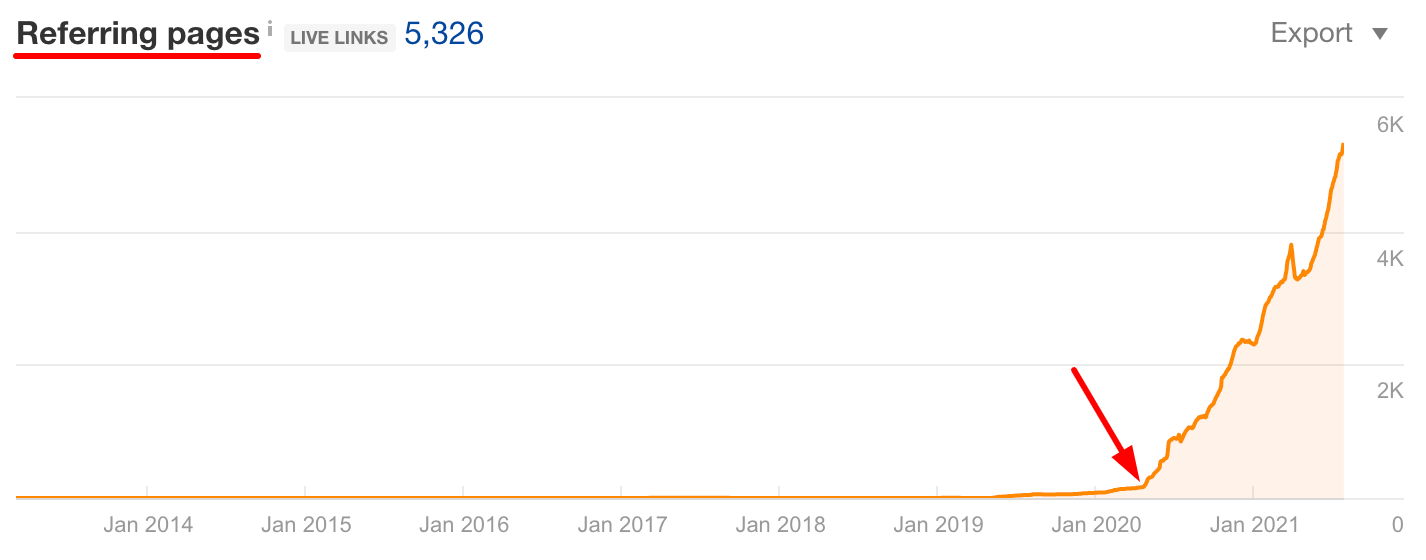
By looking at these charts, you can get a good understanding of how fast or slow you’re growing in terms of backlinks.
According to the data sources, you’ll have to decide whether you should create or re-evaluate your link-building campaign, in order to attract high-quality backlinks.
This means reaching out to relevant and authoritative websites that might be interested in using your website or content pieces as a source in their own content.
This is a tactic many marketers and SEO services specialists use in their content marketing strategy.
Let’s now have a look at a couple more features when it comes to your link analysis.
New backlinks
A great way to see how many backlinks you’ve acquired and when is by selecting “New” under “Backlinks” in Ahref’s backlink profile section on the left of the overview page.
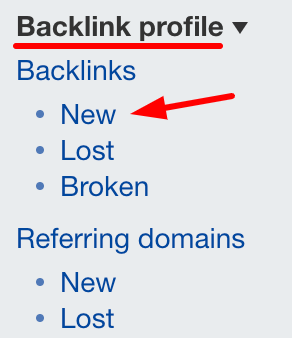
By doing this, the tool will provide you with a calendar to see how many new backlinks you acquired on each day of the month.
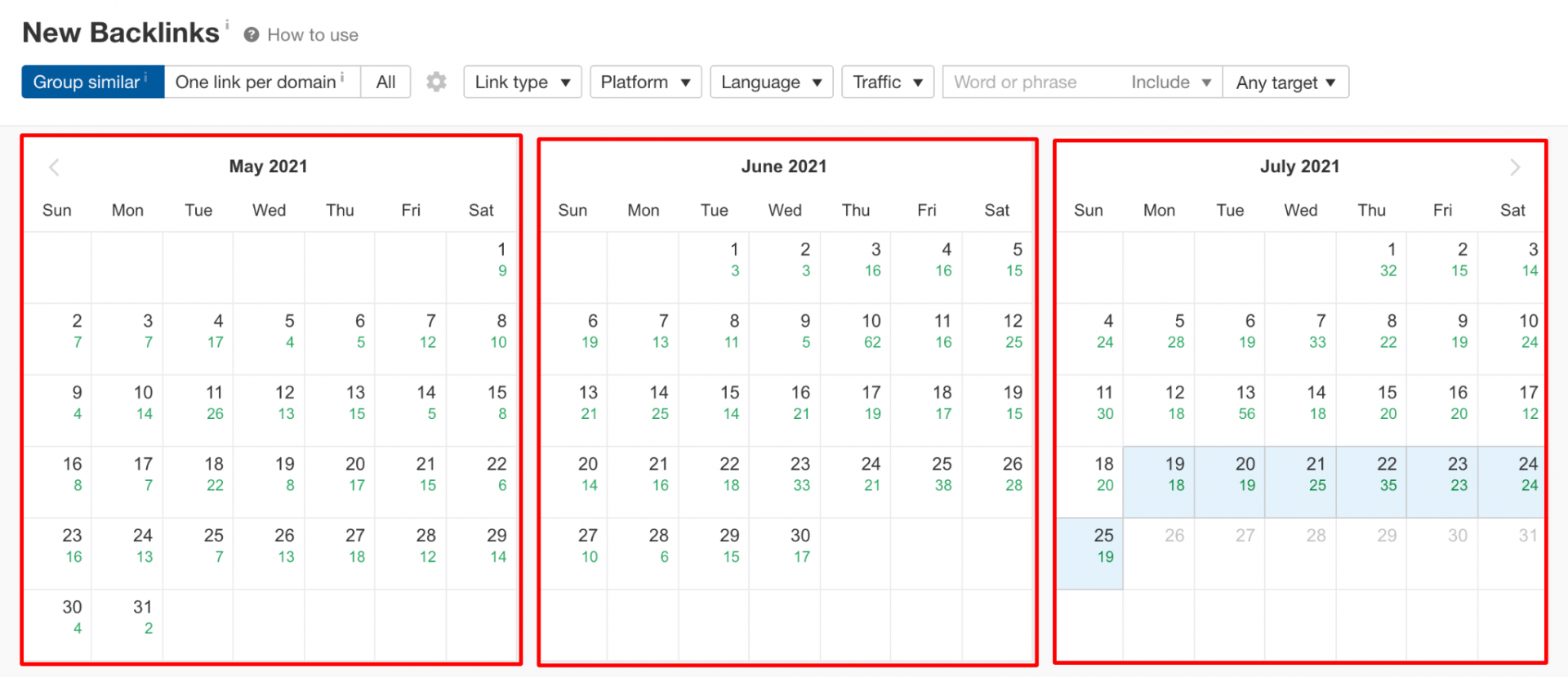
With the arrow on the top left, you can go back as many months as you like, gaining a great perspective on how many new links you attract every day and every month.
If you scroll down, you can see the total number of backlinks gathered over a certain period of time; whether that’s in the last seven, 30, or even 60 days.
For example, in the last week, we’ve acquired 132 new links and we can see exactly which ones they are, what their DR is, what anchor text they used, and much more.
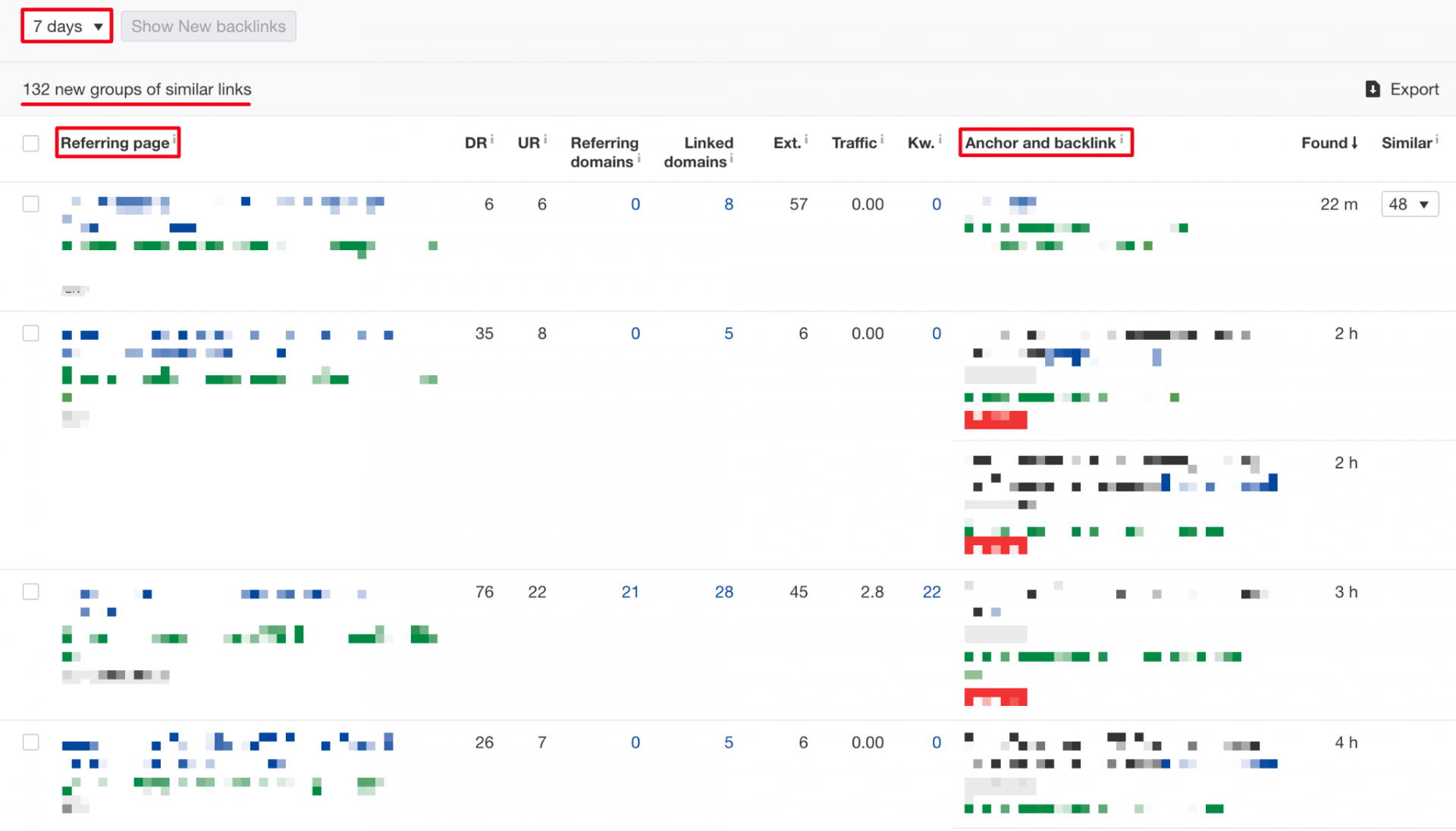
This is a great way to monitor backlinks and see whether some of them are what we call “bad backlinks”, meaning they can be spammy backlinks, or low-quality ones which you don’t want – such as links from message boards and social media comments – along with PBNs.
More on this in the fourth step, where we’ll talk about identifying toxic backlinks.
What the tool also allows you to do is set some filters to view your links.

You can choose whether you want them to be from a certain:
As well as whether you want them to include a specific word or phrase.
Overall, this is a great way to monitor backlinks and keep track of their performance.
Let’s continue to the next step.
Step #3: Check Your Link Churn
We just covered how to conduct a regular backlink audit when it comes to the new links you’ve gained; but what about the ones you’ve lost?
Similar to the feature we just saw in the previous step, you can also discover which and how many backlinks you’ve lost over a period of time.
Simply select “Lost” under the Backlink profile section on your left-hand side.
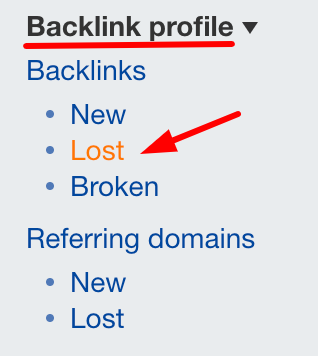
Like before, the tool gives you a calendar so you can see how many links you lost each day of a certain month.
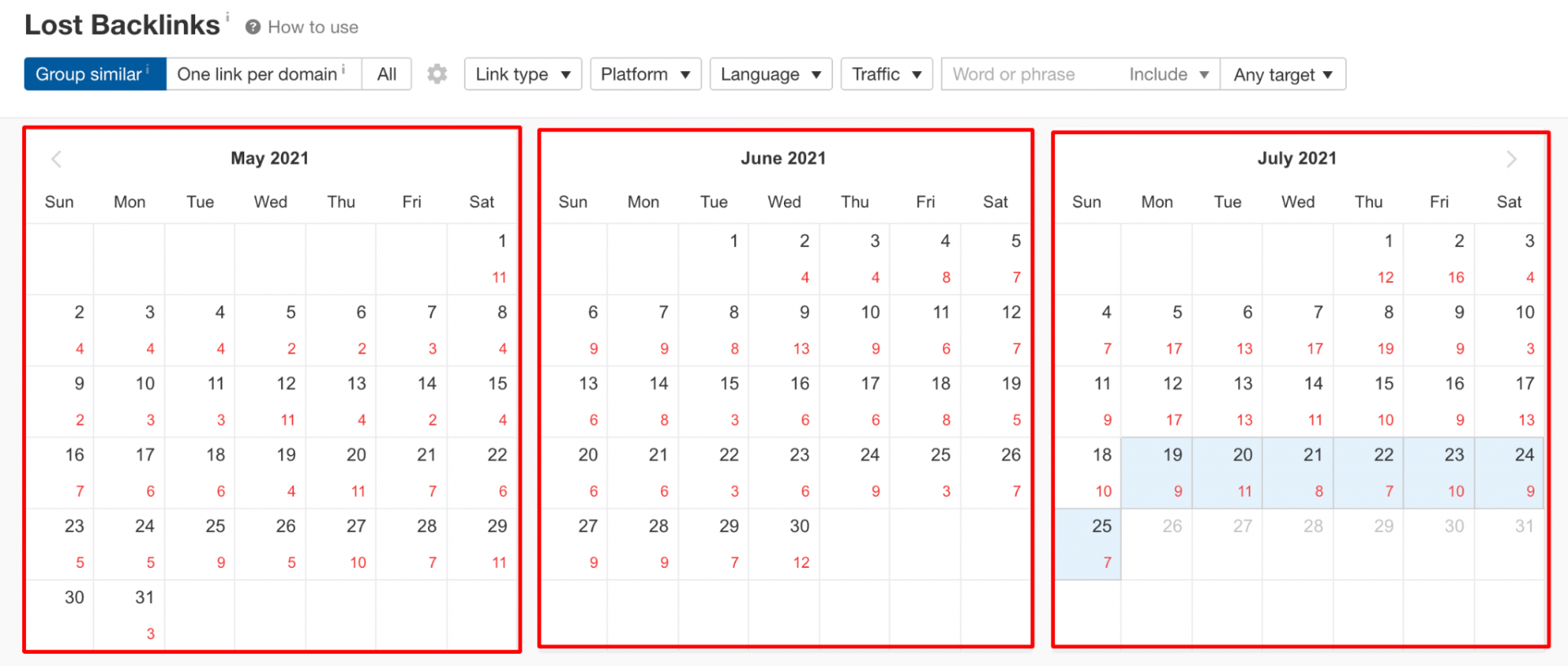
Once again, if you scroll down, you can see exactly which backlinks you lost over a certain period of time.
In our case, over the course of seven days there were 103 backlinks lost.
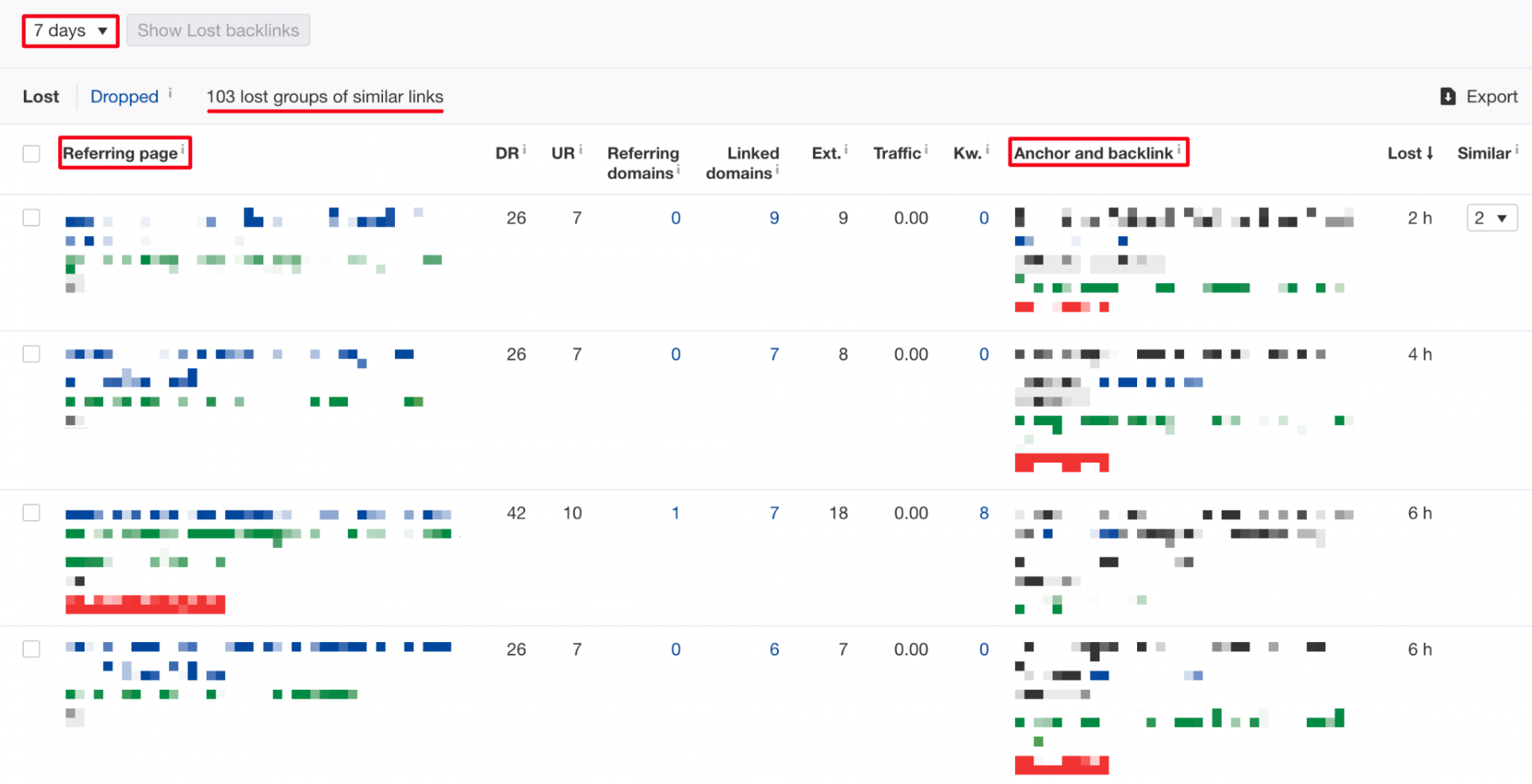
This means that over the same week, our ratio of new to lost backlinks was almost 3:1.
Another great way to monitor your lost links is from the overview page, where, if you scroll down, you’ll see two charts.
There’s one about the referring domains and one about the backlinks.
In the following screenshot, you can see what the progress of our gained and lost referring domains looks like.
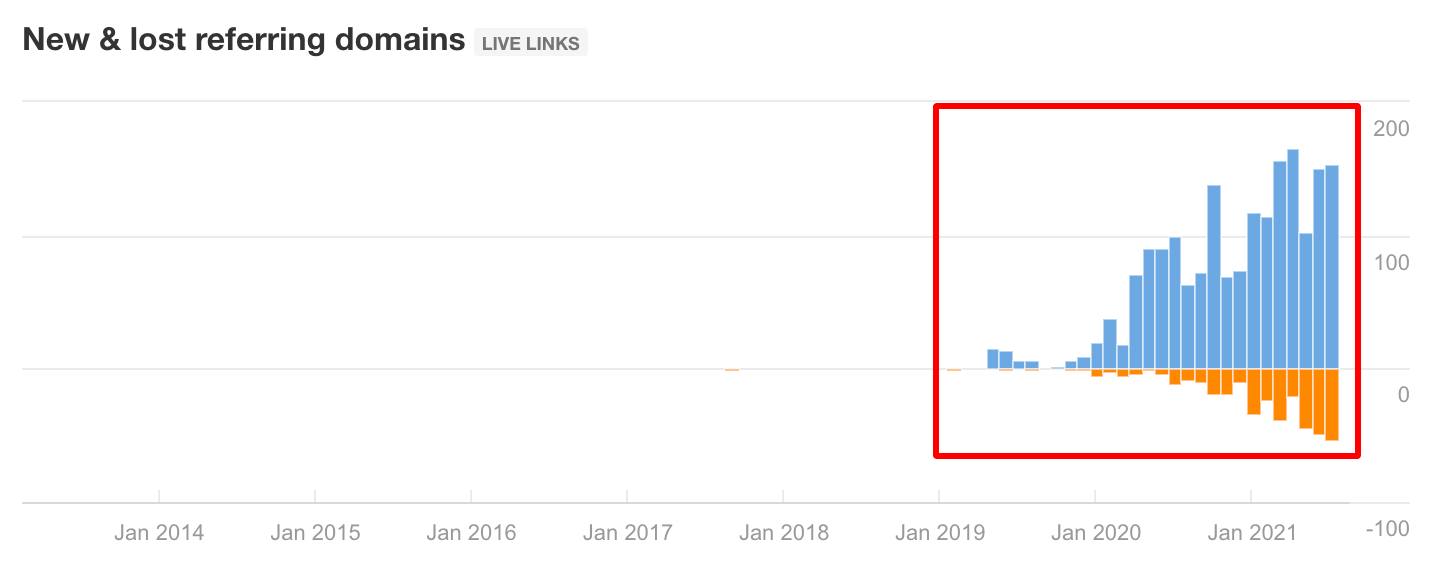
On the top half – in blue – the chart shows the new referring domains, while in the bottom half of the chart – in orange – displays the lost ones.
While it’s clearly visible that the gains are considerably more than the losses, a good tactic is to calculate the churn rate; this means the percentage of domains being removed compared to the ones being acquired.
You can calculate that for a specific period, such as a month or year. Let’s calculate our own for the month of October 2020:
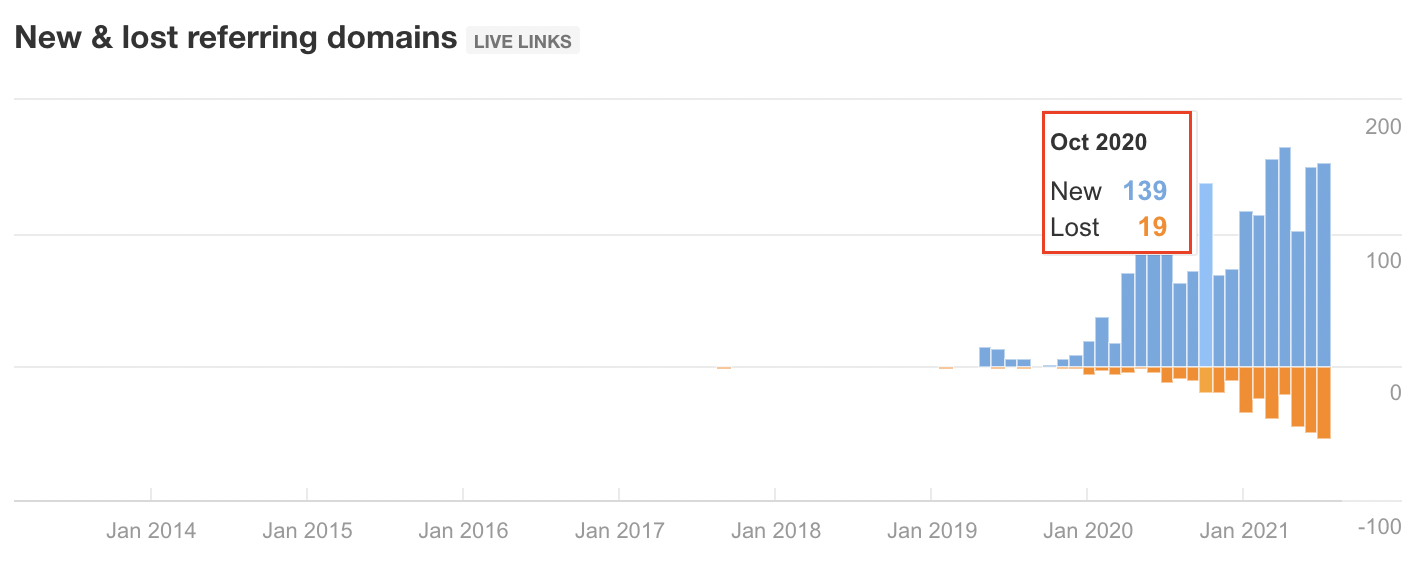
As you can see above, moving your mouse over a bar triggers a pop-up where you can see the number of new and lost domains; in our case, it’s 139 new and 19 lost.
What you’ll also need to know is the total number of referring domains at the beginning of that period; in our case, it was about 555.
The churn rate formula is:
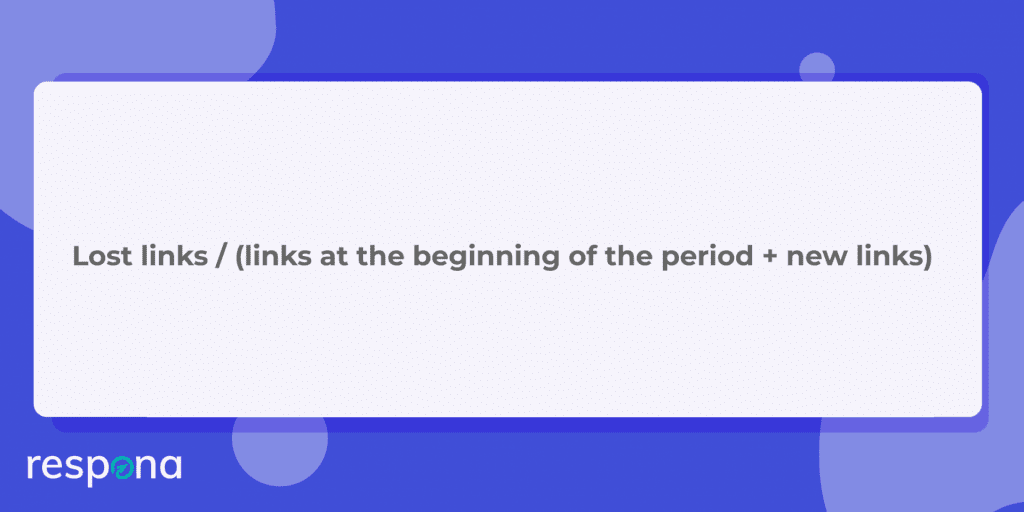
Meaning: 19 / (555 + 139) = 0.027.
This shows that we have a churn rate of 2.7% for the particular month.
Whether a churn rate is considered “good” depends on the situation, since there are many types, such as customer churn rate, revenue churn rate, and more.
Generally speaking, a churn rate of around 2-3% can be considered good.
You can do the same with your new and lost backlinks.
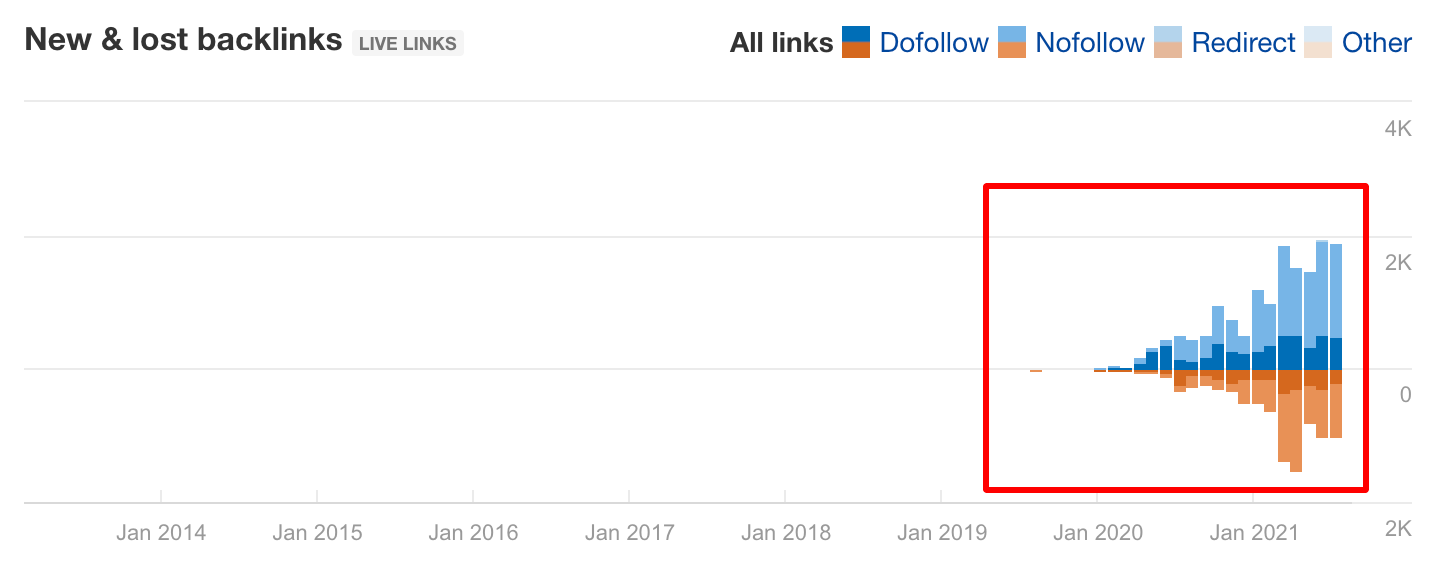
While the difference may not be as clear as before, the new backlinks outnumber the lost ones.
As you can see below, there were 984 newly acquired backlinks and 300 lost for the same month of October 2020.
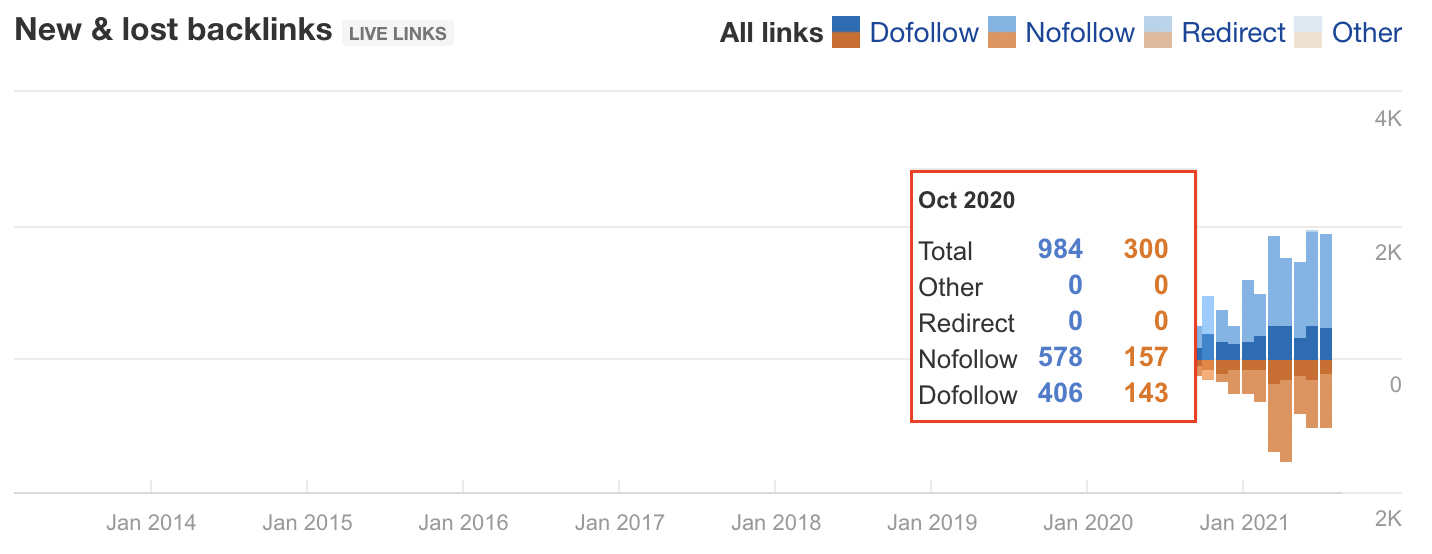
Overall, it’s good practice to keep track of the performance of your links; whether that’s backlinks, inbound links, or outbound (external links).
For instance, if you notice that, over a period of time, there are more lost links than usual, it’s interesting to find the reason why.
Maybe you changed something in the structure of your URLs or maybe someone from your team removed a large chunk of low-quality spammy backlinks.
The latter in particular is a good tactic to follow when identifying toxic backlinks.
Let’s have a closer look at it.
Step #4: Identify Toxic Backlinks
A common misconception in search engine optimization is that the more backlinks a website has, the better.
This isn’t always the case, since what matters most is the quality of those backlinks.
When reaching out to people as part of your link building SEO strategy, what you want to do is target relevant and authoritative sources, with a high DR and no spammy backlinks or content.
This will give search engines an indication that you’re also a trustworthy source and deserve to be ranked higher.
Of course, you can’t always control which websites decide to link back to you; some of them are low-quality links from spammy and irrelevant sources which do more harm than good.
That’s why identifying toxic links is a crucial part of keeping your backlink profile clean and healthy.
How do you recognize whether you need to disavow links that are bad for you?
Let’s delve a little further in this.
Check your referring domains
You can check your referring domains by going to your website’s overview page in Ahrefs and selecting “Referring domains” under “Backlink profile” on your left.
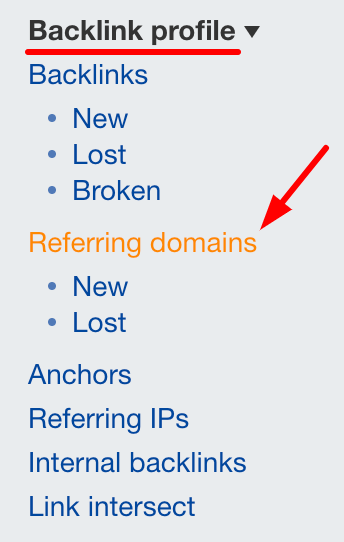
You’ll then be presented with a list of all the domains that link back to you, as well as additional information about them such as their DR, Ahrefs rank, organic traffic, and more.
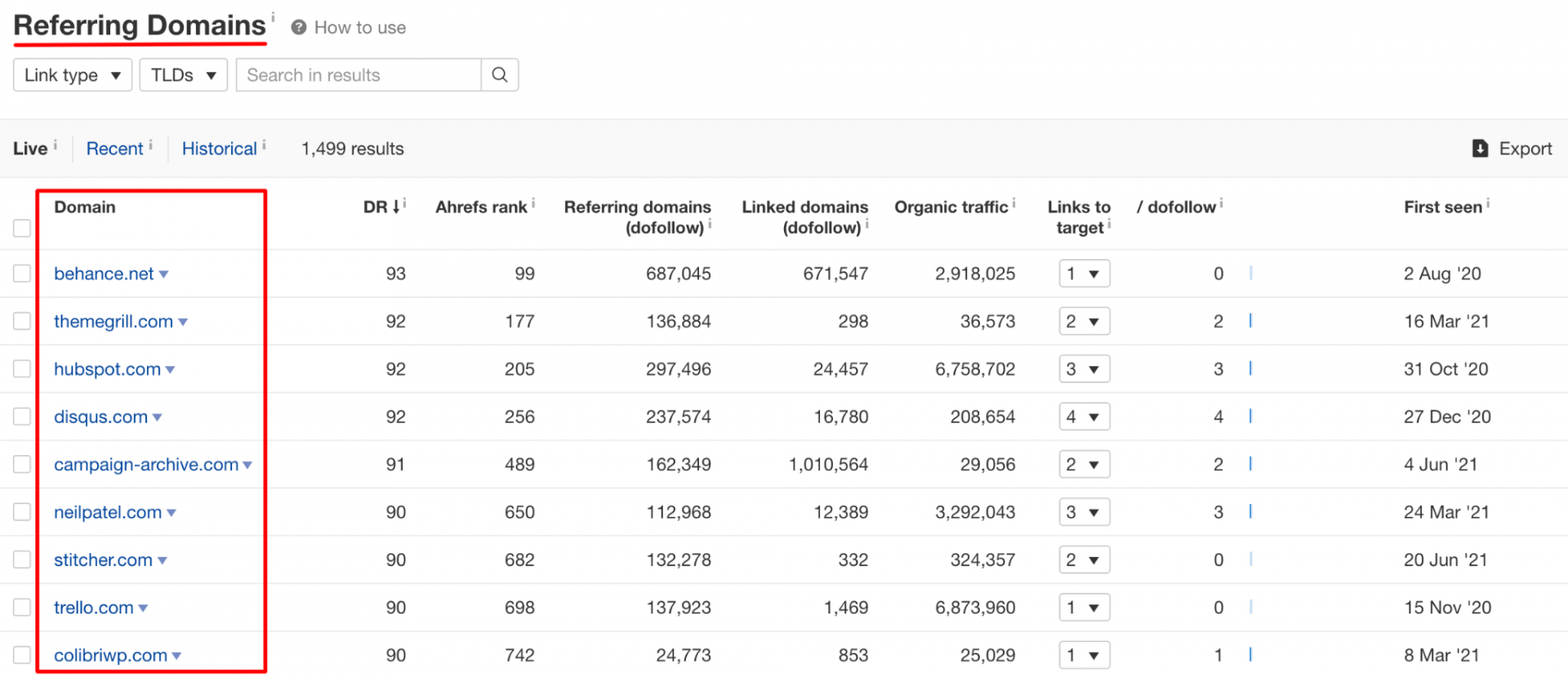
In our case, there are 1,500 referring domains, meaning there’s a good chance that not all of them are worth keeping.
The results are, by default, sorted starting from the highest DR.
At the top, we can see many high-quality and authoritative sources which we’d like to keep.
Now, let’s click on “DR” to sort the results starting from the lowest DR; this gives us a good view of all the low-quality domains that potentially might be toxic for our site.
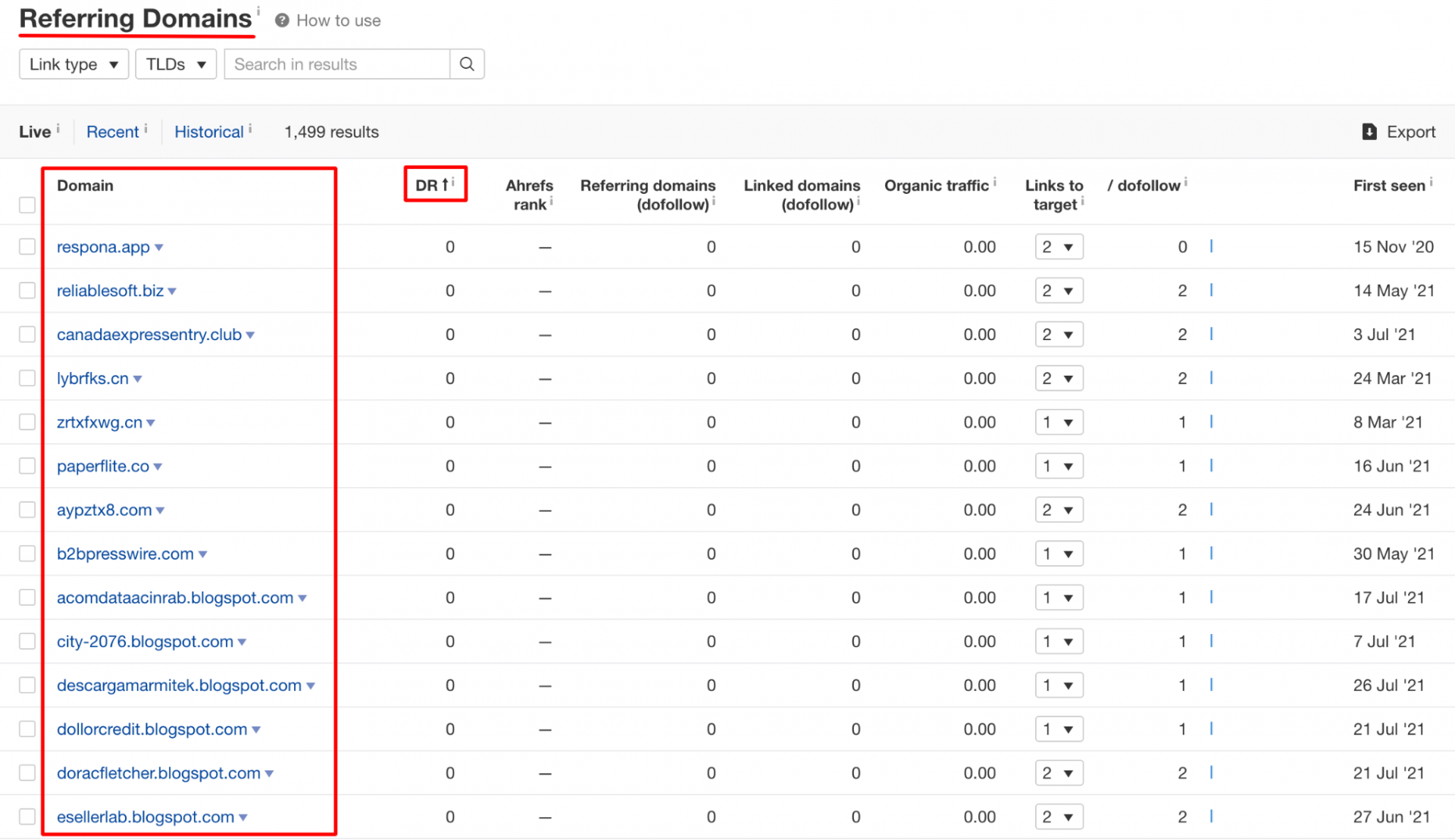
With a quick glance, we can spot many domains that aren’t valuable for us based on their very low metrics.
What’s more, if we click on a random one, such as zrtxfxwg.cn, we can see that the content is not relevant at all.
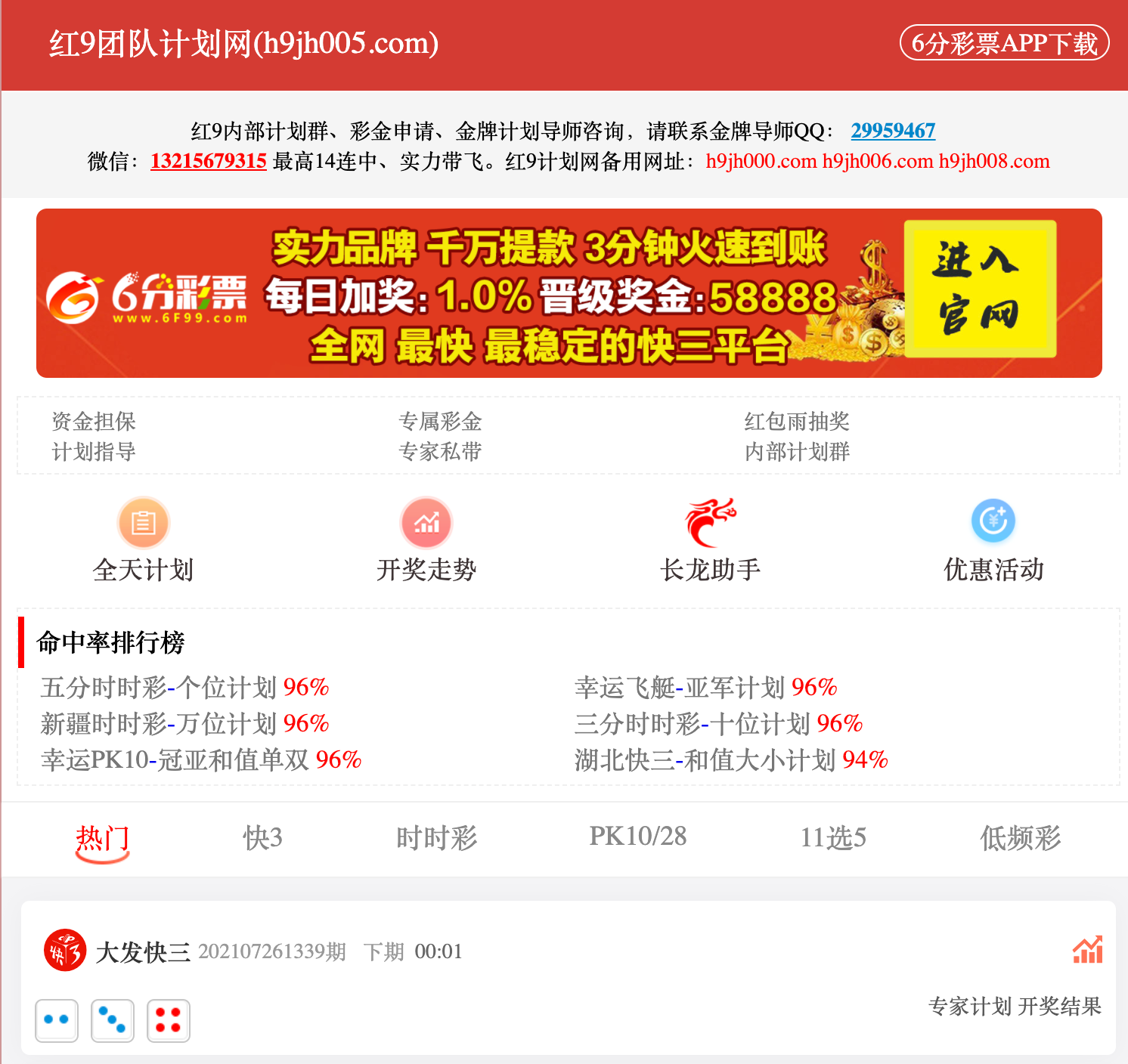
It makes sense that such a page isn’t valuable to us and could be disavowed.
By clicking on another domain, such as lybrfks.cn, we can see that the site isn’t even reachable.
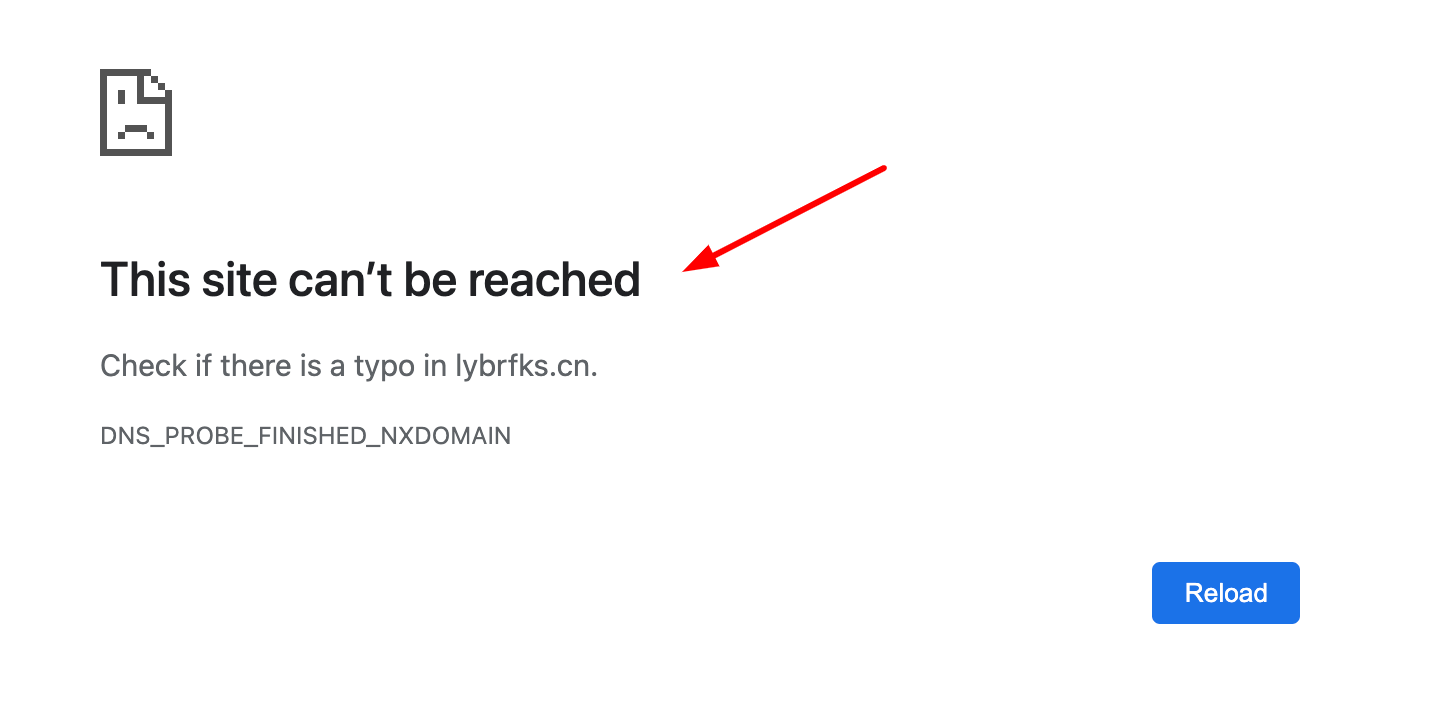
This is a clear indication of a bad link which we’d rather not have pointing back to us.
To sum up, you can scroll down your own list and check for potential harmful links from low-authority websites.
They’re usually easy to spot based on the domain name, which sometimes looks randomized, and the low DR.
However, you’ll have to double-check each one to verify that they are, indeed, toxic and irrelevant, before moving on to any link removal actions.
What else can you do?
Check the anchor texts
Having a look at the anchor texts used to link back to your website is also a good backlink audit tactic.
On the menu on your left-hand side, select “Anchors” under the “Site Explorer 2.0” section.
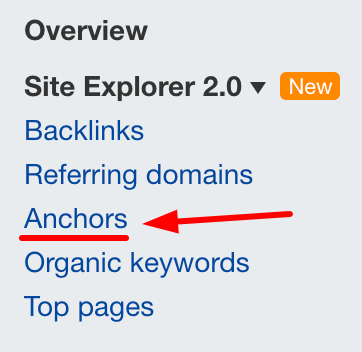
This gives you access to the anchor texts that all your referring pages have used.
In case you don’t know what an anchor text is, it’s basically the hyperlinked piece of text that the user clicks on which then sends them to another webpage.
By having a look at the list, you can see whether some anchors indicate spammy behavior or whether they’re completely irrelevant to your website and your products or services.
In our case, there are over 1,200 anchor texts from referring pages.
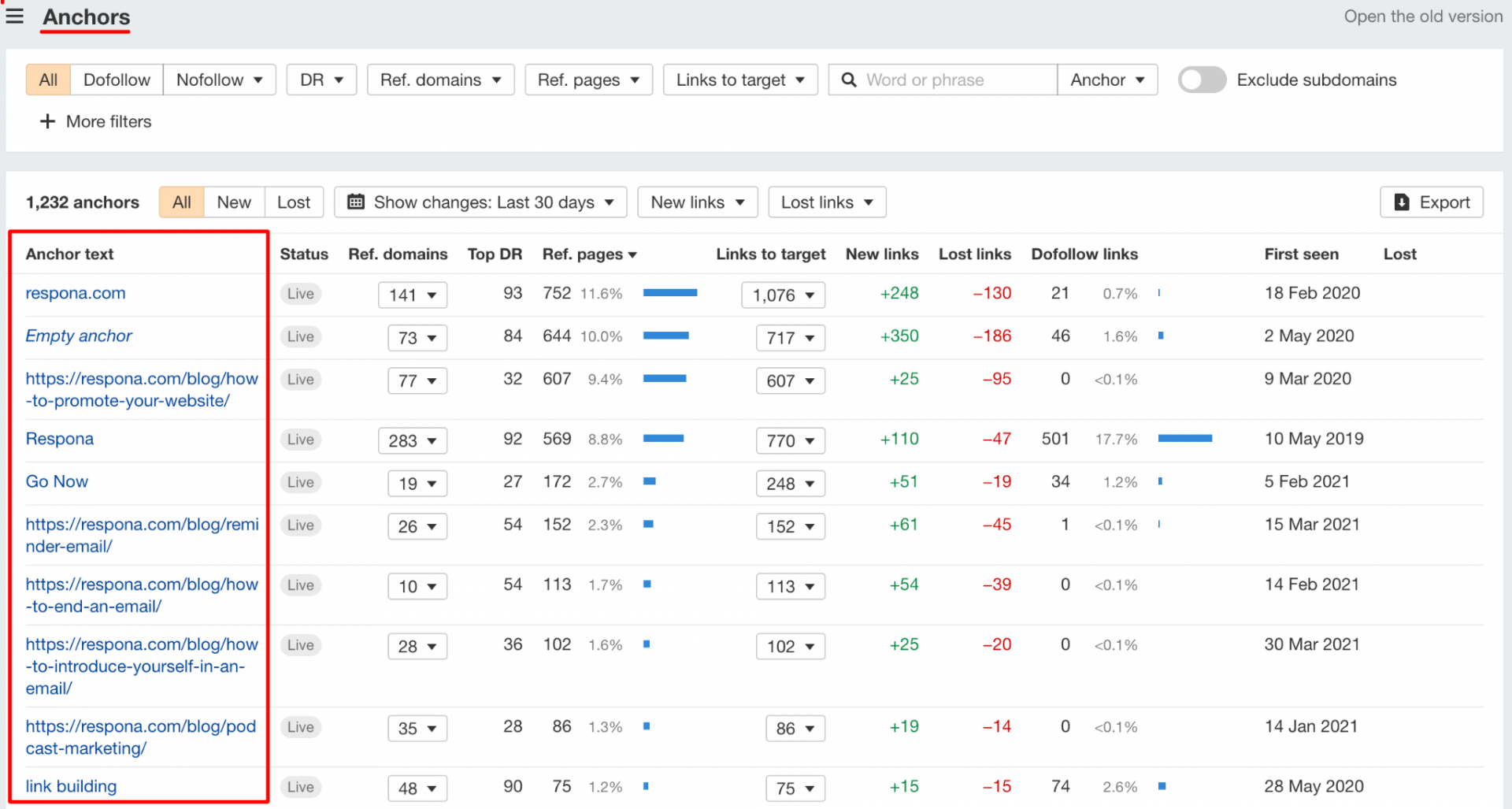
What we have to do now is check which ones are relevant and good for us and which aren’t.
Most people will use your branded term as an anchor text, but that’s not always the case.
Our branded terms “Respona” and “respona.com” are excellent anchors that we want to keep, and roughly 20% of all anchor texts use these.
This is a good indication that our backlink profile is healthy and not spammy.

Apart from anchors using our branded terms, there are many other ones we’d be more than happy to keep.
For example, “link building”, “digital PR”, and “blogger outreach” are all relevant terms to our tool’s capabilities and are examples of great anchor texts.
What does a bad anchor text look like?
Generally speaking, it’s not difficult to detect spammy and suspicious anchor texts.
By “suspicious”, we mean irrelevant anchors that indicate spammy behavior; some examples from our own list are “Get Code” and “Get Coupon”.
Both indicating referring pages that are promoting coupons and voucher codes, which is something we’re not interested in.
Another sign of spammy anchors is when you have a large distribution of different languages.
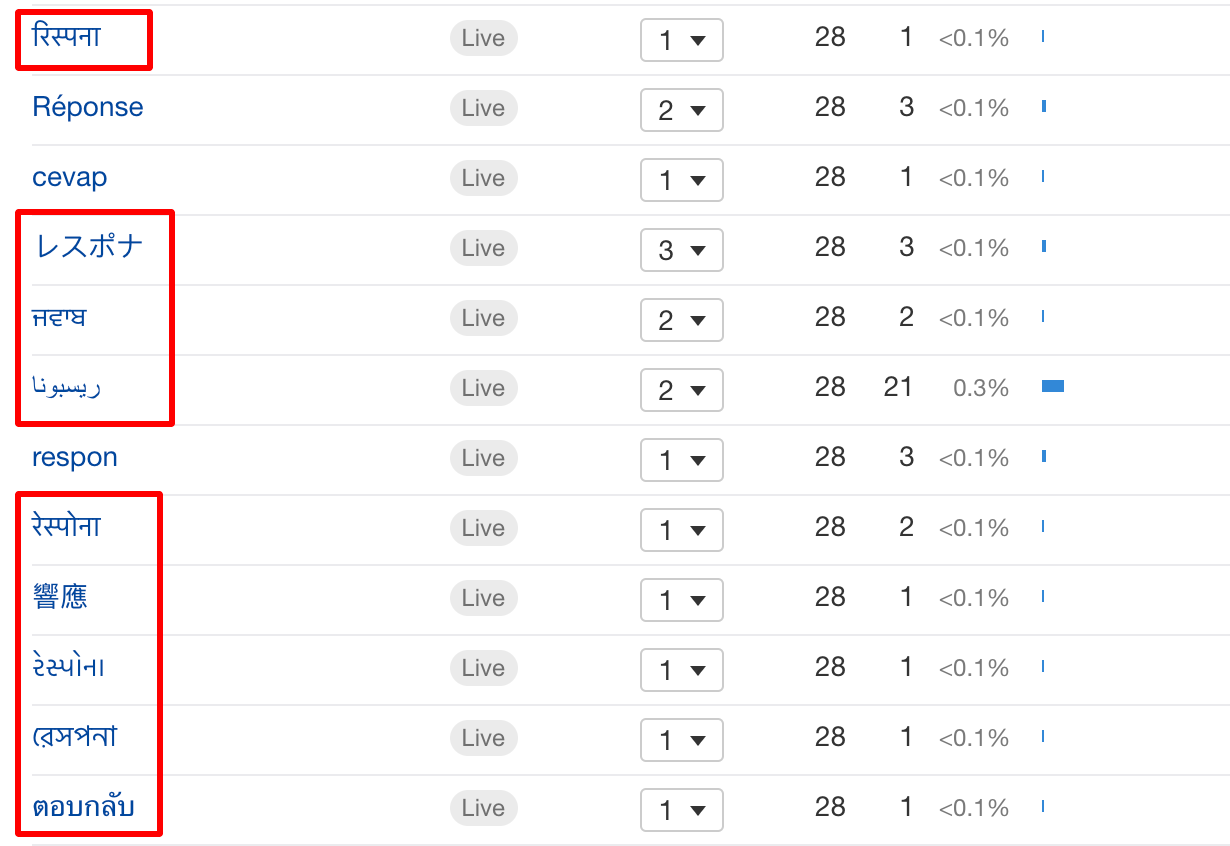
This doesn’t necessarily mean they’re toxic backlinks, but we strongly recommend looking deeper into them to discover if they’re indeed relevant and trustworthy.
Let’s continue.
CTLDs distribution
Another thing you can do to identify toxic backlinks is to have a look at your CTLDs distribution; in simpler terms the countries where you get most of your backlinks from.
By looking at the distribution, you can get an idea of whether you have a large number of spammy CTLDs from uncommon domains and countries irrelevant to your target audience.
This is what ours looks like:
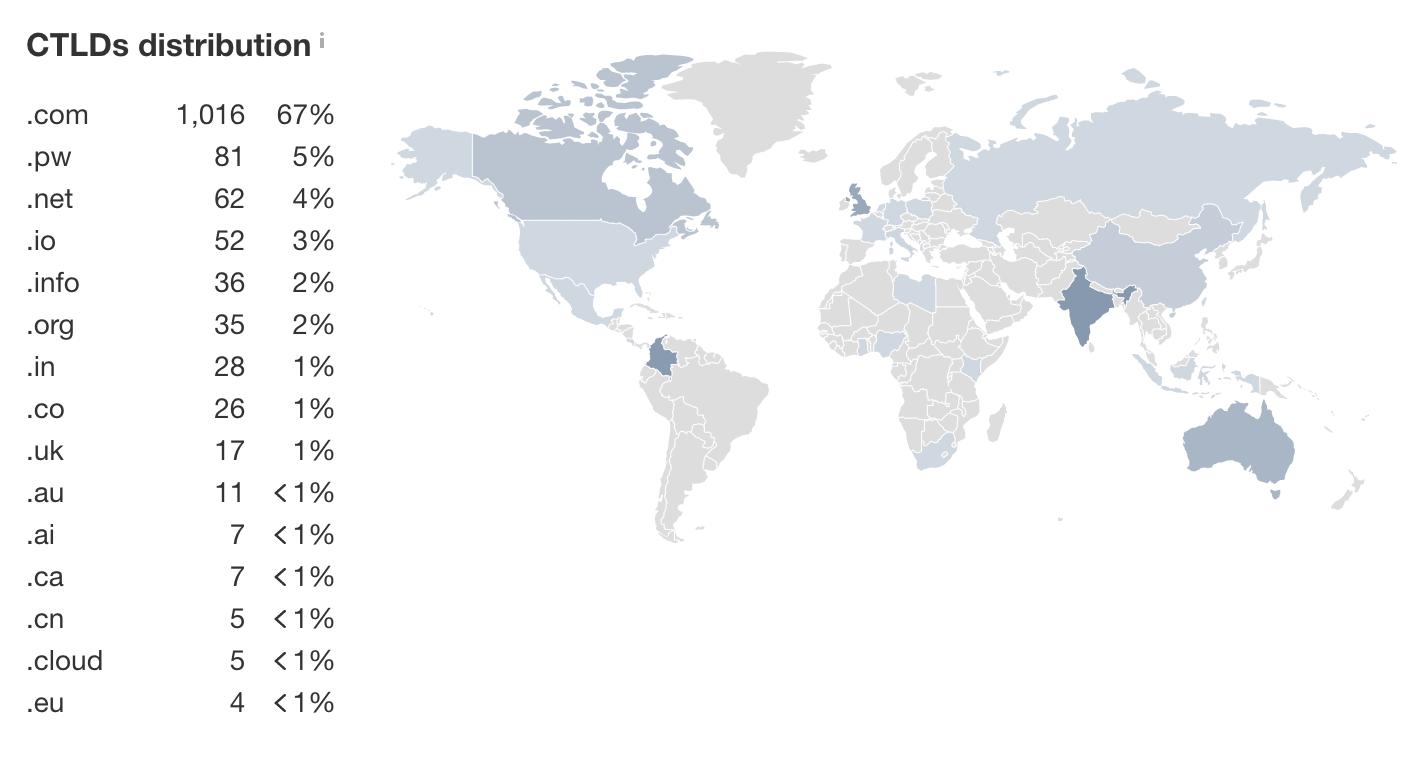
As you can see, 67% of our referring domains end in “.com” which indicates a healthy backlink profile, as well as quite a few from “.net”, “.org”, “.io”, and other non-spammy TLDs.
Does that mean that all the rest are spammy?
Certainly not, but there’s a higher chance they are.
For instance, the second-highest TLD for us is “.pw”, which is the domain for Palau.
If the percentage of it was <1% we wouldn’t worry about it, but 5% gives us an indication that we should delve further into finding potential spammy backlinks.
Moving on to the last action you can take to identify toxic backlinks.
Identify negative SEO attacks
When looking at the progress of your referring domains and pages, the charts won’t always look nice and smooth.
Sometimes there are certain anomalies that result in spikes; usually when it comes to the referring pages.
Fortunately, this isn’t the case for Respona, but in the screenshot below you can see an example of a negative SEO attack.
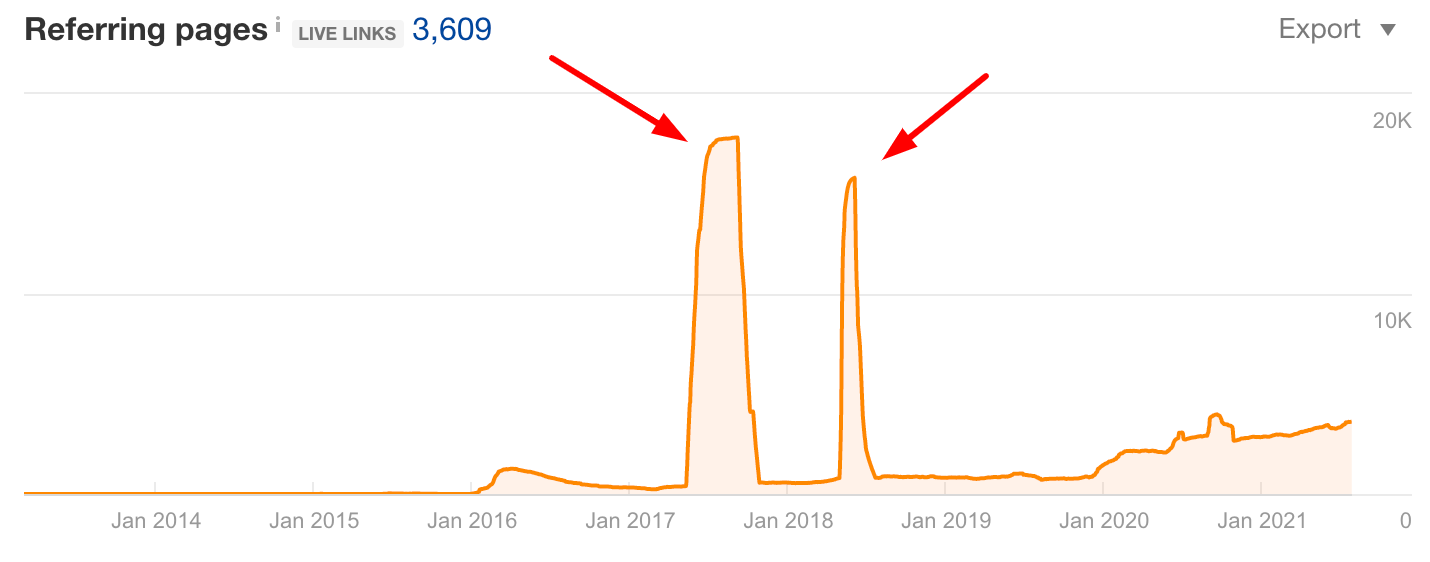
As you can see, around May 2017 and the same month the next year, there were two abnormal surges in referring pages, followed by an equally big drop.
This is a possible indication of an unhealthy backlink profile and the spikes could possibly be a result of an influx of spammy backlinks.
Most of the time, Google can recognize bad links so you probably won’t receive what’s called a Google penalty.
Simply make sure to be aware of the link schemes that Google has defined when it comes to manipulating links, such as featuring paid links.
You can also pay attention to the Google Webmaster Guidelines, in order to know which practices are considered illicit.
Lastly, it’s important to mention that, once you’ve identified your toxic backlinks, you need to enter them into an Excel sheet.
This will be your disavow file that you’ll submit to Google through your Google Search Console account, basically telling the search engine that you want those backlinks to be ignored.
You can even use the Google disavow tool to help you remove unwanted links, in case you can’t do it any other way.
Moving forward to the next step.
Step #5: Check Your DoFollow to NoFollow Ratio
This step is all about calculating the ratio of DoFollow to NoFollow links.
What we must do first, however, is explain what these two types of links mean:
- DoFollow: This is a link that allows search engine bots to follow it and find the source page
- NoFollow: This is a link that prevents search engine crawlers from following it, by applying an HTML tag (rel=nofollow)
What you ideally want is to have a higher number of DoFollow links than NoFollow links.
This is because NoFollow links can be paid or affiliate links, as well as spammy ones.
What’s more, they don’t contribute to increasing your DR; they don’t pass the link juice from one website to another.
Let’s say, for example, that you’re writing a content piece about low-quality and spammy backlinks; if you want to feature a certain one you’ll have to “nofollow” it so you don’t help search engines rank it higher.
How do you measure the ratio of those two types of links?
All you have to do is go to the “Referring domains” on the left of your overview page in Ahrefs, just as we saw in step four.
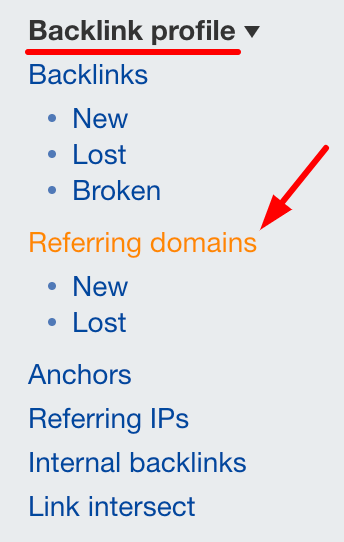
When you see the list of all the domains linking back to you, make sure to click on “Link type”.
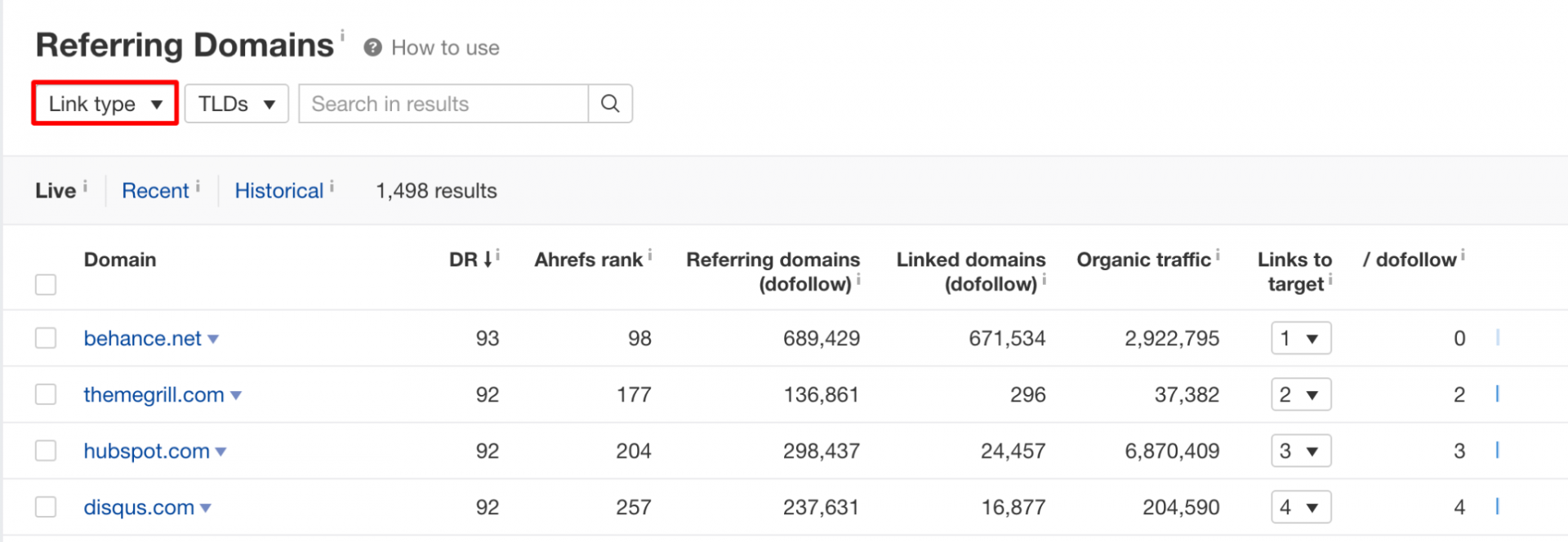
From the drop-down list, you can select to view the DoFollow, as well as the NoFollow links.
You can even see how many they are in the parenthesis next to them.
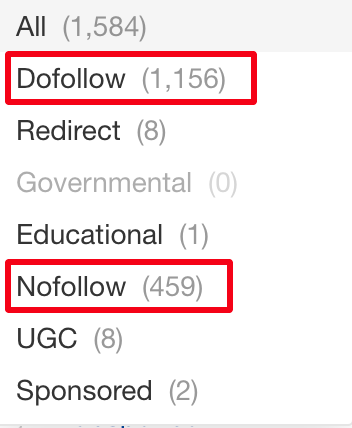
In our case, we have 1,156 DoFollow links and 459 NoFollow ones.
This is a ratio of just under 3:1 since the ratio formula is:
Dofollow links / Nofollow links
When you plug in our numbers, we get 1,156 over 459, giving us 2.71.
This means that there are 2.71 time more DoFollow links than NoFollow ones, or else we can say they outnumber them 2.71:1.
If we round up the ratio, it comes out at 3:1.
This is great because you don’t want your NoFollow links to outnumber your DoFollow ones.
Let’s move on to the last step of the backlink audit.
Step #6: Check Your Referring Pages to Referring Domains Ratio
Another interesting metric to be aware of is the ratio of referring pages to referring domains.
This is important because a website might have a large number of backlinks from the same domain, which is something that doesn’t indicate a healthy backlink profile.
Having many backlinks from a wide variety of different domains is more preferable in the eyes of Google’s algorithm.
By simply going to the overview page of your website that Ahrefs provides you with, you can see the number of referring domains and backlinks.
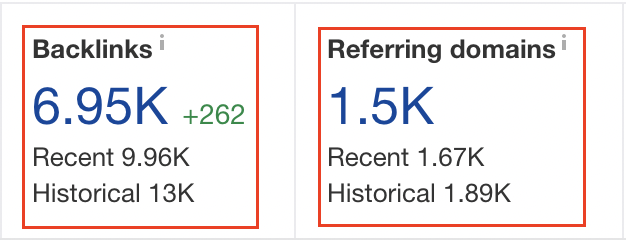
As you can see, in our case, backlinks are higher than the referring domains but not abnormally more.
By using a similar formula to the one above, this ratio is just under 5:1, since:
Backlinks / referring domains = 6.95K/1.5K = 4.63K.
Our backlinks are 4.63 times higher than our referring domains, or we can say that they outnumber them 5:1 if we round the number up, as we did earlier.
All in all, those are the most essential steps you should follow when performing a backlink audit.
Let’s move on to a helpful checklist we’ve created for you.
Grab Our Backlink Audit Checklist
By now, you should have a good understanding of the basic elements that a regular backlink audit consists of.
While it’s not difficult to conduct one, it’s important that you organize all your data in a file for maximum efficiency, giving you a single place to see an overview of the audit.
This will help you make more informed decisions and stay on top of your research; that’s exactly why we create a complete backlink audit checklist that you can use for free.
As you’ll see, we’ve divided the checkpoints into seven main categories:
- Anchors
- Backlinks
- General
- Link velocity
- Referring domains
- SEO
- UX
Each one has a different number of checkpoints attributed to it, but they’re all equally important.
Let’s have a closer look.
Category #1: Anchors
There are six different questions you can answer regarding this category, such as which are the most-used anchor texts and whether there’s any indication of spammy ones.

You’ll also see the source we suggest you use to find each answer; you can enter the outcome in the “Outcome” column.

Moving on to the next category.
Category #2: Backlinks
Next up, you can fill in some information regarding backlinks, such as how many come from homepages, the top incoming site languages, and more.
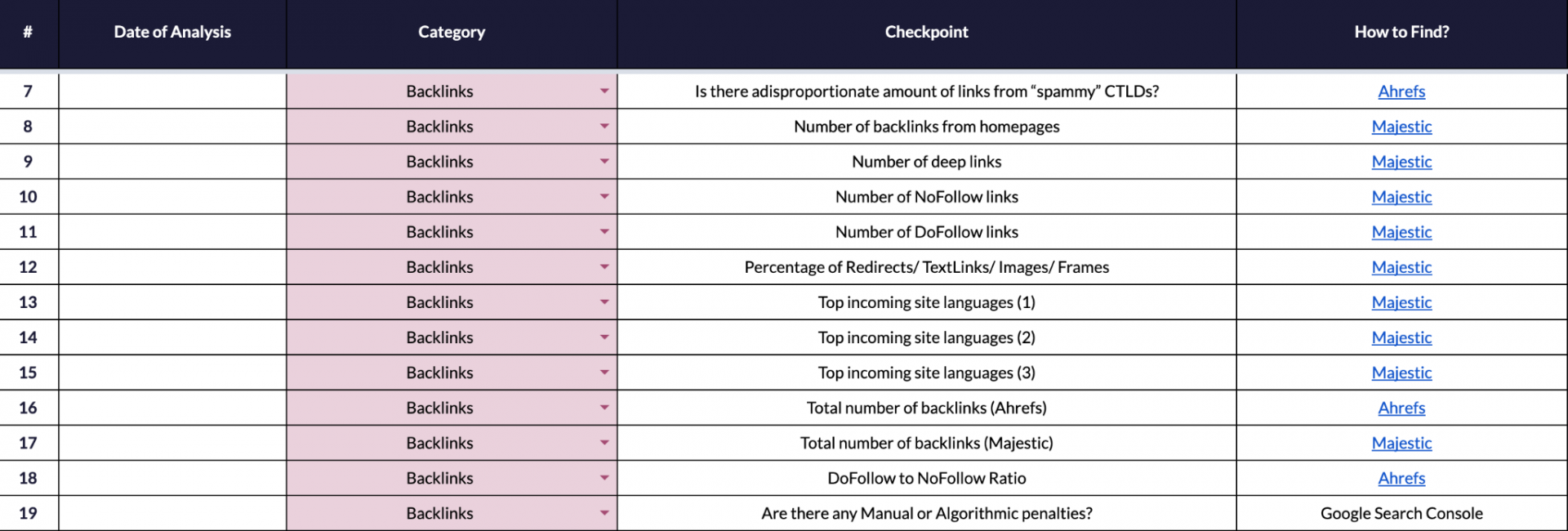
Once again, you should add the outcome as well as the date of the analysis for your own convenience.
Let’s continue.
Category #3: General
The next category is marked as “General” and you can enter data around how your backlink profile compares to your competitors, your most linked pages, and more.

Let’s move on to the next.
Category #4: Link velocity
In this part of the checklist, all you’ll have to do is answer exactly how your backlink profile is growing.

When you go to the “Outcome” column, you’ll notice an arrow; make sure to click it to see the drop-down list.
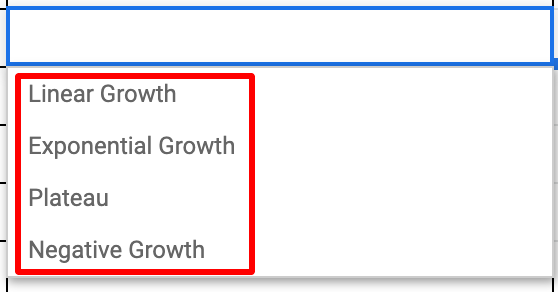
You can then select whether your backlink profile is growing, plateaued, or is declining in performance.
Let’s see the next category.
Category #5: Referring domains
What you can do here is add the referring pages to the referring domains ratio.

Simple as that, we showed you how to calculate this in step six.
Moving on.
Category #6: SEO
Here, you can enter data around potential negative SEO attacks, your backlink and traffic growth, and more.

We suggest being as descriptive as possible when elaborating on each answer.
Let’s move on to the last category of our checklist.
Category #7: UX
As you may know, UX refers to the user experience when someone is visiting a website.
One factor that contributes to a bad UX is when a user clicks on broken links.

You’ll have to make sure that all backlinks you receive are linking back to your live pages.
This will ensure users have a positive user experience when trying to be directed to and around your website.
Overall, those were the seven categories on our checklist.
You can download the backlink audit checklist and give it a go.
Link building cheat sheet
Now It’s Your Turn
There you have it!
Even if you’re an amateur at SEO, we believe that our step-by-step guide will help you in conducting a great backlink audit for your website. Alternatively, you could simply outsource your backlink audits to an SEO company.
Keep in mind that, despite not being a difficult process, there are many things to pay attention to so our checklist will come in handy.
If you believe that you have a weak or unhealthy backlink profile, then it’s time to start building a powerful link outreach strategy.
Feel free to start your 14-day free trial with Respona to get the most out of your outreach process.
Thanks for reading!






